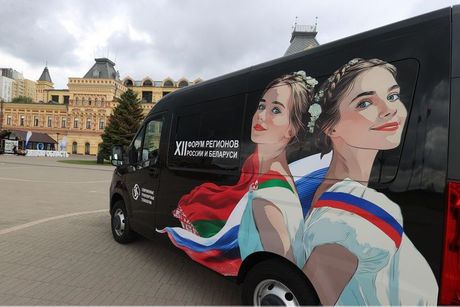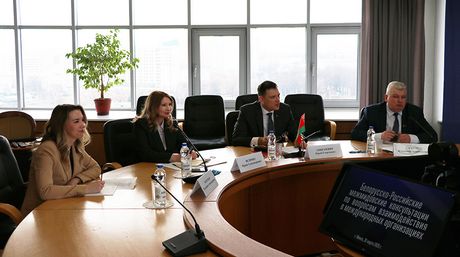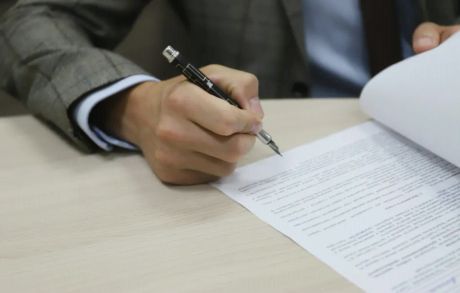Belarus’ first cosmonaut back on Earth. How did her journey to the stars end?
19:30, 6 April

photo: BELTA
Not only entire Belarus but also entire Russia watched the first Belarusian cosmonaut Marina Vasilevskaya’s space flight for two weeks. And the rest of the world would occasionally glance with interest at how a woman, who represented a small European country and was not a professional cosmonaut, could confidently and bravely overcome all the difficulties of the space flight while smiling charmingly. Specialists call the landing of the reentry vehicle one of the riskiest parts of the space mission. A BelTA reporter was in Roscosmos’ mission control center in Korolyov outside Moscow to watch how it happened.
- Поделиться в Facebook
- Поделиться ВКонтакте
- Поделиться в Twitter
Per aspera ad astra and back
Marina Vasilevskaya had to worry quite a lot at the start of her space Odyssey although she never let it show: her character and the experience of her previous job with the air carrier Belavia where she had to be ready for any unexpected events may have contributed to it. Certainly, the crew, which also included the commander, Hero of Russia and Belarus’ native Oleg Novitsky and the NASA astronaut, U.S. citizen Tracy Dyson, was also trained for various off-nominal situations. Including for a situation when the launch scheduled for 21 March was cancelled by automatic systems virtually seconds before the ignition of the engines of the Soyuz-2.1a carrier rocket.
As a result, the crew transfer vehicle Soyuz MS-25 was successfully launched on the backup day of 23 March, however, the journey to the International Space Station took two days because of it: ballistic conditions no longer allowed docking according to the original ultra-short two-loop scheme, which takes 3.5 hours. A traditional two-day flight scheme had to be used. Specialists say that the traditional flight to the ISS may be lengthy but it is reliable: it is possible to make course corrections at every stage of the journey if something goes wrong. However, it was quite a difficult test for cosmonauts: Soyuz ships have a lot of advantages and one significant disadvantage - they are cramped. Each of the three crew members has only 1.2m3 of free space taking into account the habitation module. Besides, the ship keeps spinning all the time, testing the vestibular apparatus of those on board.
Preparations for landing
Fortunately, Marina Vasilevskaya’s consequent 12-day stay at the International Space Station and the crew’s return to Earth proceeded without surprises. Preparations for landing began virtually right after the crew reached the space station. Partially because the crew had to return to Earth on board the Soyuz MS-24 ship, which docked at the ISS back in September 2023. This is why it was necessary to move individual seat liners of the cosmonauts and their spacesuits from one ship to another, do preventive maintenance on the mechanisms for sealing the hatches, charge the necessary devices using solar cells, move returning equipment, including samples produced as a result of Marina Vasilevskaya’s experiments in orbit. Apart from that, the crew’s composition changed: instead of Tracy Dyson Marina Vasilevskaya and Oleg Novitsky were supposed to land on Earth together with the NASA astronaut Loral O'Hara, who was at the ISS as part of a long-term expedition.
People on the ground started preparations for the landing process a long time before the scheduled date: preliminary calculations of the descent trajectories taking into account the current ISS orbit and parameters of the docked ship were verified. It had to be done because mass and centering parameters of the ships change when useful load returns from the station to Earth together with cosmonauts.
Several days before the landing search and rescue parties were deployed to the main landing area and the backup one. They included medics and about 200 Russian military personnel and were fitted with Mi-8 helicopters, An-12 and An-26 aircraft, ground vehicles, including the search and evacuation vehicles PEM-1 and PEM-2 Blue Bird. They maintained air watch and ground watch outside the population centers Zhezkazgan and Arkalyk in order to find the reentry vehicle on time and ensure the safety of the Soyuz MS-24 crew.
Comparatively soft landing
The cosmonauts’ return to Earth included several stages. Once the crew moved from the ISS to Soyuz MS-24, the closing of the hatches began. The ship undocked from the ISS at about 7 in the morning on 6 April.
About 2.5 hours after undocking Soyuz MS-24 turned on engines to begin planned descent from Earth’s orbit. The engines had to fire for only 4.5 minutes: the duration of their work is calculated with a very high degree of precision. Specialists say that even one second moves the landing site by 8km.
Approximately half an hour after Soyuz MS-24 started moving towards Earth, it was split into several modules: the landing module was separated from the habitation module and the instrumentation-propulsion module. And virtually right away the landing module entered high-density atmosphere strata.
By entering the atmosphere at an altitude of 100km, the landing module had to pass the most complicated and dangerous stage: it was enveloped in flames with temperatures as high as several thousand degrees. The crew cannot communicate for several minutes due to this phenomenon and experiences colossal gravity stress of up to 4G. It is at this point that the automated descent control system decides whether it can ensure landing at the specified coordinates. If the automated systems are shut down, the landing module has to experience so-called uncontrolled ballistic descent. It is possible to find out which trajectory the module follows only after radio communication is resumed. If ballistic descent happens, then the module lands in the backup landing area, which is much larger than the main area and requires more time to find the crew.
Fortunately, unlike the launch process the automated systems did not fail the landing process: the landing module routinely landed at 10:17 Minsk time about 150km to the southeast of the city of Zhezkazgan, Kazakhstan. It was a soft landing thanks to the main parachute with the area of 1,000m2, which opened at an altitude of several kilometers and considerably reduced the descent speed, and thanks to special engines, which are fired only several meters above the ground. However, one can say it was a comparatively soft landing. Cosmonauts never talk to the mission control center at this time because the shock of landing is comparable to the crash of a car against a truck. One can bite his or her tongue and even dislocate the jaw at this moment.
Helicopters landed next to the landing module virtually right away. Rescue workers opened the hatches and helped the crew get out of the module. The commander Oleg Novitsky came out first. He was followed by Loral O'Hara. Marina Vasilevskaya was the last one to exit the lander.
The cosmonauts were carried and put into armchairs right away. Medics started examining them, measuring their pulse and blood pressure. A Belarusian flag appeared in Marina Vasilevskaya’s hands right away. It is worth noting that Oleg Novitsky also had a Belarusian flag: the flag was on the cosmonaut’s cap while an arm of his spacesuit had an image of the Russian flag.
Right after landing Belarus President Aleksandr Lukashenko congratulated the crew on successful landing. The head of state invited the entire crew and the people, who had taken care of preparations for the flight, to visit Belarus as guests.
“People, appreciate Earth!”
Belarusian reporters were some of the first people, who rushed to the cosmonauts in addition to medics and rescue workers. Some of them even helped the crew a bit. Naturally, the reporters were the first to talk to Marina Vasilevskaya on the ground.
“Belarus, thanks for support!” Marina Vasilevskaya said during the first interview after landing. “I wish all the people on Earth to appreciate and take care of everything we have,” she stressed.
“We knew that people on the ground were waiting for our return and it warmed our souls. Belarus is here, I am very glad. I could have spent two more weeks in flight but Earth was waiting for me,” Belarus’ first cosmonaut added.
It is worth noting that the flight of Belarus’ first cosmonaut was a most complicated mission for Belarusian mass media. A team of reporters from the main mass media had to visit the most important venues as they worked hard to cover this event of great importance for independent Belarus: the cosmonaut training center in Zvyozdny Gorodok outside Moscow, the mission control center, the Baikonur Cosmodrome, and even Kazakhstan plains where they had to go even despite record-breaking flooding. According to Kazakhstan President Kassym-Jomart Tokayev, the country has not seen such floods for over 80 years.
BelTA reporters were also in the epicenter of all events and covered them in detail. Thanks to smooth work of BelTA’s team it was possible to track the training of the cosmonauts, the launch of the carrier rocket, the ship’s docking at the ISS, and the crew’s return to Earth in real time on BelTA’s website, in BelTA’s Telegram channel, and via social networks. The reporters worried and felt joy about the cosmonauts just like the entire country did.
Space work
Belarus President Aleksandr Lukashenko was the initiator of the nationwide project for training the first Belarusian cosmonaut. President of Russia Vladimir Putin backed his idea and gave instructions to prepare a space flight of Belarus’ representative nearly two years ago. It was soon revealed that Belarus would send a woman into the outer space first. The Belarusian head of state personally oversaw the entire process of the selection of candidates and their training.
The main crew member Marina Vasilevskaya was not a space tourist. While at the ISS she carried out a research program, which had been developed by the National Academy of Sciences of Belarus in association with Roscosmos and the Russian Academy of Sciences. It included seven experiments: five for the sake of scientific research and two for education purposes. The scientific studies focused on biology, physiology, autonomous operation of space stations, the remote sensing of Earth using photo and video spectrum equipment of Belarusian make already on board the International Space Station. The lactoferrin and probiotics made by scientific organizations of the National Academy of Sciences of Belarus were examined as well in order to evaluate the possibility of using them later to create food for cosmonauts.
During a pre-landing briefing Deputy Head of the Aerospace Activities Department of the National Academy of Sciences of Belarus (NASB) Ivan Bucha told reporters that Marina Vasilevskaya had done her space work. “Apart from that, I also received information about events of the entire mission program. Everything that was supposed to be done during the space flight, all the experiments have been fulfilled,” he said. The results these studies will produce for Belarus and not only Belarus will be revealed in the near future.






